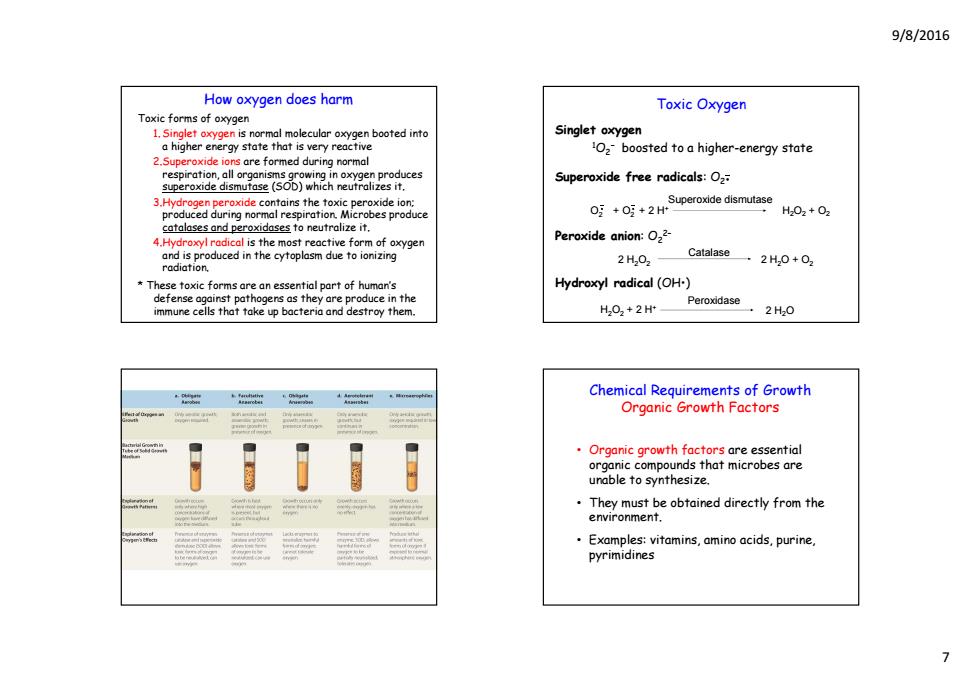
9/8/2016 Chemical Requirements of Growth Trace Elements Microbes require small amounts of other mineral elements .Trace elements:iron,copper,molybdenum,and zinc 2 .Function as cofactors and are essential for ATP activity of certain enzymes May be added to media but assumed to be found in tap/distilled water and other 000 Vitamin B1 components used to make the media Chemical Requirements of Growth Oxygen COFACTOR Me5thenisam9noEfegBoractnoreenergy Binding Obligate aerobe:only aerobic growth:oxygen required site Facultative anaerobe:both aerobic and araerobic growth: INACTIVE greater growth in the presence of axygen PROTEIN Obligate anaerobe:only anderobic growth:ceases growth in presence of oxygen Without the cofactor coestarbanieg Aerotolerant anderobe:only anaerobic growth:continues attached,the protein growth in presence of oxygen is not active. protein. Microaerophilic:only oerobic growth:oxygen required in low concentrations:lower than ai 6
9/8/2016 6 ATP Vitamin B1 Chemical Requirements of Growth Trace Elements • Microbes require small amounts of other mineral elements •Trace elements: iron, copper, molybdenum, and zinc • Function as cofactors and are essential for activity of certain enzymes • May be added to media but assumed to be found in tap/distilled water and other components used to make the media Chemical Requirements of Growth Oxygen Microbes that use molecular oxygen extract more energy from nutrients than those that do not. • Obligate aerobes are at a disadvantage since oxygen is poorly soluble in water • Obligate aerobe: only aerobic growth; oxygen required • Facultative anaerobe: both aerobic and anaerobic growth; greater growth in the presence of oxygen • Obligate anaerobe: only anaerobic growth; ceases growth in presence of oxygen • Aerotolerant anaerobe: only anaerobic growth; continues growth in presence of oxygen • Microaerophilic: only aerobic growth; oxygen required in low concentrations; lower than air

9/8/2016 How oxygen does harm Toxic Oxygen Toxic forms of oxygen 1.ingletyis normal molecular xy booted into Singlet oxygen a higher energy state that is very reactive 1O2 boosted to a higher-energy state 2.Superoxide ions are formed during normal respiration,all organisms growing in oxygen produces superoxide dismutase(SOD)which neutralizes it. Superoxide free radicals:O2 3.Hydrogen peroxide contains the toxic peroxide ion: produced during normal respiration.Microbes produce HSuperoxde dimutase H02+O2 catalases and peroxidases to neutralize it. 4.Hydroxyl radical is the most reactive form of oxygen Peroxide anion:O22- and is produced in the cytoplasm due to ionizing radiation. 2H202 Catalase一.2H,0+02 These toxic forms are an essential part of human's Hydroxyl radical (OH-) defense against pathogers as they are produce in the immune cells that take up bacteria and destroy them. H202+2H roxidase.2H Chemical Requirements of Growth Organic Growth Factors Organic growth factors are essential organic compounds that microbes are unable to synthesize. They must be obtained directly from the environment. .Examples:vitamins,amino acids,purine. pyrimidines >
9/8/2016 7 How oxygen does harm Toxic forms of oxygen 1. Singlet oxygen is normal molecular oxygen booted into a higher energy state that is very reactive 2.Superoxide ions are formed during normal respiration, all organisms growing in oxygen produces superoxide dismutase (SOD) which neutralizes it. 3.Hydrogen peroxide contains the toxic peroxide ion; produced during normal respiration. Microbes produce catalases and peroxidases to neutralize it. 4.Hydroxyl radical is the most reactive form of oxygen and is produced in the cytoplasm due to ionizing radiation. * These toxic forms are an essential part of human’s defense against pathogens as they are produce in the immune cells that take up bacteria and destroy them. Singlet oxygen 1O2− boosted to a higher-energy state Toxic Oxygen Superoxide free radicals: O2 Peroxide anion: O22– Superoxide dismutase O2 + O2 + 2 H+ H2O2 + O2 Hydroxyl radical (OH•) Catalase 2 H2O2 2 H2O + O2 Peroxidase H2O2 + 2 H+ 2 H2O Chemical Requirements of Growth Organic Growth Factors • O i th f t s Organic growth factors are ss ti l essential organic compounds that microbes are unable to synthesize. • They must be obtained directly from the environment. • Examples: vitamins, amino acids, purine, pyrimidines